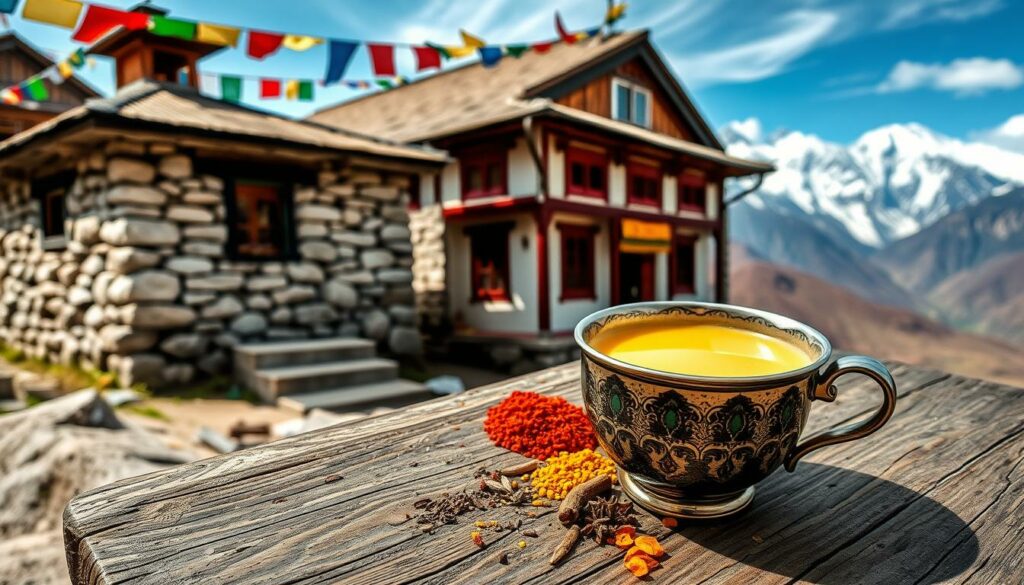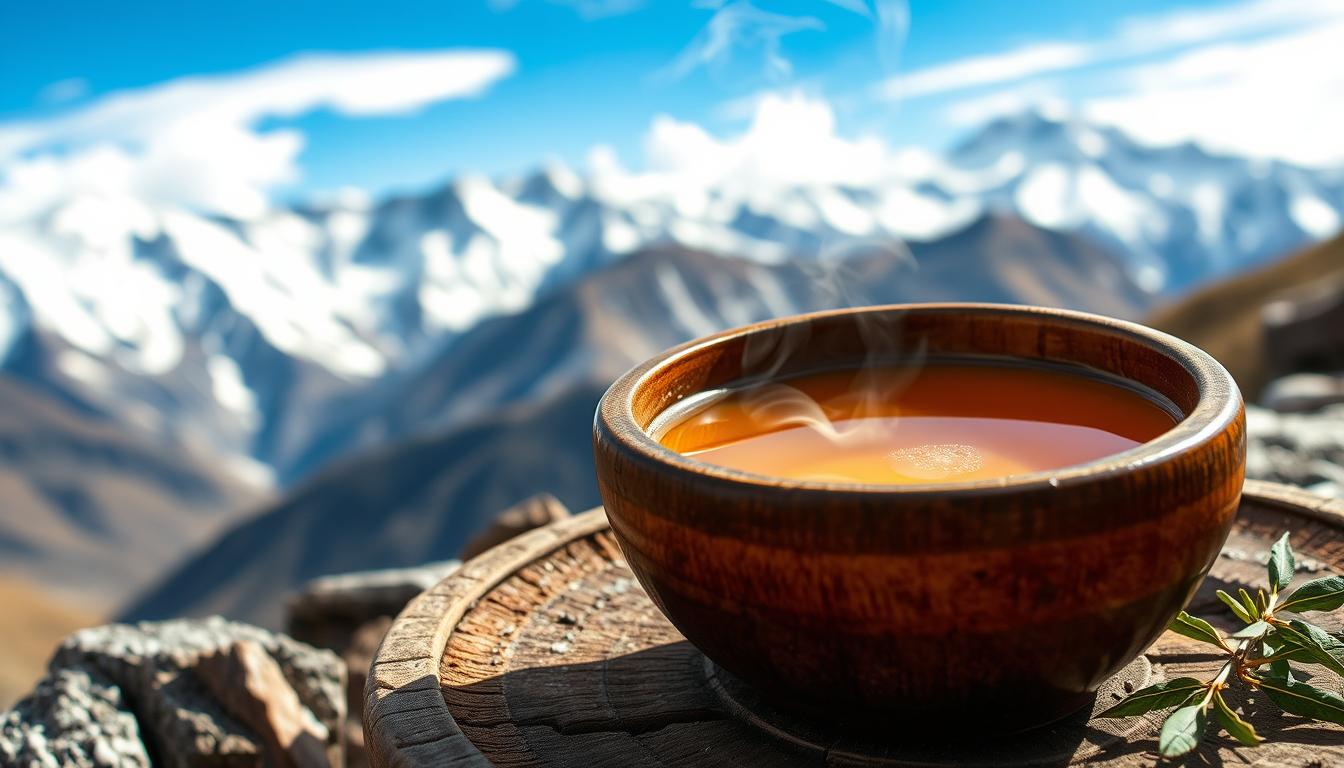Want to try a unique cultural drink? Think about Tibetan butter tea, or Po cha. This traditional Tibetan drink combines brick tea, salt, and yak butter. It’s a must-have in Tibet for its unique taste and health benefits. The tea offers high calories and warmth. This is crucial for people living in the cold, high-altitude areas of Tibet.
Tibetans drink Po cha up to 40 times a day, usually in wooden bowls. Though traditionally made with a special tea called Pemagul, many now use Lipton or black tea. Making this tea will give you two cups each for two people. For the best taste, blend or churn for two to three minutes.
Enjoying this delicious salt tea recipe lets you experience Tibet’s rich drink culture. It’s a blend that offers warmth and nutrition, cherished by Tibetans for generations.
Key Takeaways
- Tibetan butter tea, or Po cha, is a traditional high-caloric drink essential for cold high-altitude regions.
- Modern recipes often use Lipton tea or plain black tea as a substitute for traditional Pemagul tea.
- The recipe typically serves two people, providing two cups of tea each.
- Churning or blending the tea mixture is recommended for a better taste.
- Tibetan butter tea is traditionally consumed up to 40 times a day.
What is Tibetan Butter Tea?
Tibetan Butter Tea, known as po cha, is more than a drink in Tibet. It stands as a warm symbol of hospitality in the cold Himalayan region. People in Nepal, Bhutan, India, western China, and Mongolia also enjoy it.
Background and Cultural Significance
Butter tea’s history started around the 13th century with Pu-erh tea bricks from China. Monks have used it for energy during long temple chants. It’s crucial for surviving the tough, high-altitude climate.
It brings warmth and hydration. It’s part of daily life and crucial events like births and funerals. Butter tea is everywhere in Tibetan culture.
“Tibetans would be constantly sipping Tibetan butter tea all day to stay warm and avoid dehydration at high altitudes,” noted a British author.

Unique Ingredients
The unique taste of this drink comes from special ingredients and methods. It starts with strong black tea, usually made from Pu-erh tea bricks. Then, salty yak butter is mixed in. This makes the tea frothy. Some now use cow or goat butter as a substitute.
The Lhasa Moon Tibetan cookbook shows how these ingredients make a lot of tea. The taste is slightly oily but mild for frequent sipping. Here are the traditional ingredients:
- Strong black tea (preferably Pu-erh tea)
- Yak butter (or cow or goat butter as alternatives)
- Salt
- Water
This mix not only shows Tibet’s culture but also helps with warmth and energy in the Himalayas.
Health Benefits of Drinking Po cha
Tibetan Butter Tea, or Po cha, is not just a warm drink. It has been enjoyed for over 1,500 years, offering important health benefits.
Warming and Caloric Benefits
Butter tea is full of calories, making it perfect for those living in Tibet’s cold, high places. It keeps energy up and the body warm. Drinking it helps avoid chapped lips caused by dry, windy weather.
The mix of black tea, salt, butter, and milk is a calorie-rich combo. It gives lasting energy for hard work. This drink is key for those feeling weak or tired.
Digestive and Cognitive Health
Po cha also helps with digestion. Caffeine and antioxidants in black tea lower stomach acid and boost metabolism. It helps with indigestion and keeps the digestive system healthy.
Besides aiding digestion, it sharpens the mind. The caffeine keeps focus sharp without making you hungry, acting as an appetite suppressant. Antioxidants in the tea enhance heart health, immunity, and may reduce bad cholesterol.
However, there are some drawbacks to consider, like weight gain, high blood pressure, and sleep issues. The salt in butter tea might increase blood pressure. Too much caffeine can cause headaches or anxiety.
Here is a quick look at the main health pros and cons:
| Health Benefits | Potential Side Effects |
|---|---|
| Warming & energy-boosting | Weight gain |
| Moisturizing qualities | Hypertension |
| Improved digestion | Sleep disorders |
| Cognitive enhancement | Insomnia |
| Cardiovascular health | Anxiety |
Po cha, when drunk in moderation, can greatly benefit your physical and mental health.
Salt Tea Recipe: How to Make Po cha at Home
Making your own Tibetan butter tea at home is easy and fun. This lets you enjoy its rich, unique taste right in your kitchen. Called Po cha, it’s a favorite in Tibet, Nepal, and Bhutan. The recipe uses simple ingredients and has easy steps. Here’s your guide to making this delightful salt tea yourself.
Ingredients Needed
- 1 quart (4 cups) of water
- 2 bags of black tea (e.g., Organic Lapsang Souchong)
- 1/4 teaspoon salt (preferably Himalayan pink salt)
- 1 teaspoon milk powder
- 2 tablespoons unsalted butter (cow butter can be a substitute)
Step-by-Step Instructions
- Simmer the Tea: Start by boiling 4 cups of water in a pot. Then, add the black tea bags and let them simmer for hours for a strong brew.
- Add Salt and Butter: After the tea’s ready, take out the bags. Now, put 1/4 teaspoon of salt and 2 tablespoons of butter in the pot.
- Blend the Mixture: Put the tea mix in a blender. Blend it for 2 minutes until it’s frothy and smooth.
- Serve Hot: Pour the tea into mugs and enjoy it hot. Savor your very own homemade salt tea.
This easy guide helps you make traditional Himalayan butter tea at home. This DIY Tibetan butter tea recipe is great for those wanting to try Tibetan culture. And thanks to modern tools like blenders and tea bags, it’s simple to prepare homemade salt tea.
Alternative Ingredients You Can Use
Traditional yak butter and dri’s milk might be hard to find. But you can use other ingredients to make butter tea that tastes similar. Here are some easy swaps you can make:
- Butter Alternatives: If you can’t get yak butter, use unsalted cow’s butter or goat butter. They’re easy to find and keep the tea creamy and rich.
- Milk Substitutes: No dri’s milk? Cow’s milk and goat milk are great choices. They’re common and make the tea taste and feel similar.
- Tea Substitutes: If Tibetan tea bricks are out of reach, try black tea like Lipton or Pu-erh tea. They can closely match the authentic taste of Tibetan Po cha.
Let’s look at how different milks compare nutritionally:
| Type of Milk | Calories | Fat | Protein | Sodium | Potassium |
|---|---|---|---|---|---|
| Yak Milk (Traditional) | 80 | 7g | 4g | 50mg | 150mg |
| Cow’s Milk | 68 | 4g | 3.3g | 50mg | 130mg |
| Goat Milk | 69 | 4.1g | 3.6g | 50mg | 140mg |
Using these alternatives for Po cha lets you enjoy a similar taste and health benefits. No matter where you are, these swaps make it easy to enjoy this delicious drink.
Conclusion
Tibetan butter tea, or Po cha, means a lot to Tibet’s culture. It has been important for hundreds of years. Its making and ingredients, like yak butter and salt, are unique. Po cha is more than a daily drink. It’s also part of ceremonies.
The benefits of Tibetan butter tea are many. It provides warmth and energy, which is great in cold places. The mix of tea and butter helps with digestion and staying hydrated. It might even boost your immune system because of the salt. This drink is both nourishing and comforting.
Learning to make homemade Po cha lets you experience Tibetan culture. The process of mixing brewed tea, yak butter, salt, and sometimes milk is special. Making it at home brings you closer to Tibetan traditions. It’s a way to enjoy its benefits and connect with Tibet’s heritage.
Tea is loved worldwide in many forms. Adding Tibetan butter tea to your life brings new flavors and traditions. Enjoy the warmth and health benefits of Po cha. Discover the deep cultural value and health perks in each cup.

No responses yet